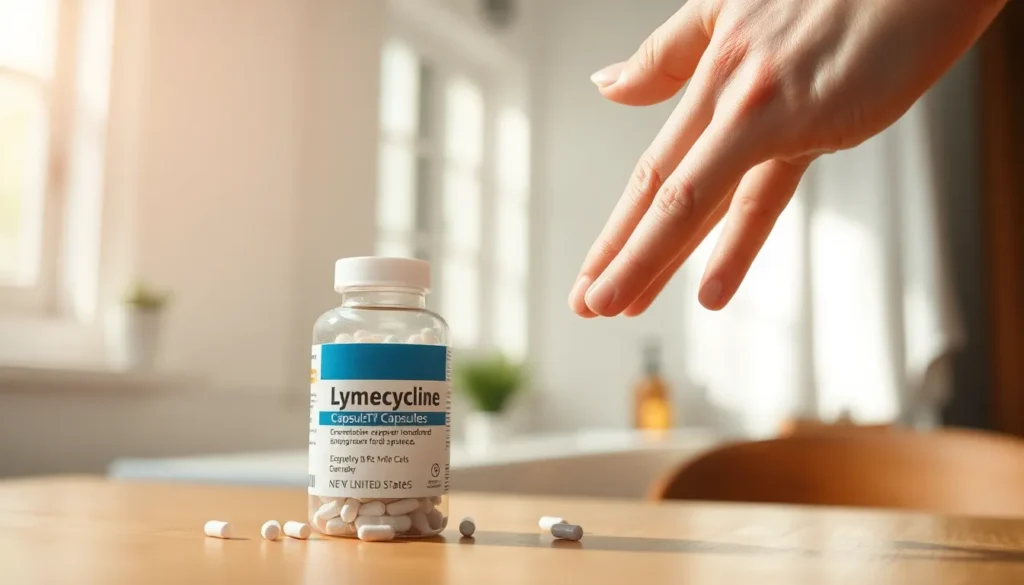When it comes to battling pesky skin conditions, lymecycline often steps into the ring like a superhero in a lab coat. But just how long does it take for this antibiotic to unleash its powers? If you’re tired of waiting for results and just want your skin to stop throwing tantrums, you’re not alone.
Table of Contents
ToggleUnderstanding Lymecycline
Lymecycline is a tetracycline antibiotic used primarily to treat bacterial infections and acne. Its mechanism involves inhibiting bacterial protein synthesis, leading to reduced growth of harmful bacteria on the skin. Medical professionals often prescribe it due to its effectiveness and favorable side effect profile.
The duration for lymecycline to take effect varies by individual and the condition being treated. Most patients start noticing improvements within 4 to 12 weeks, depending on several factors, such as skin type, severity of acne, and adherence to the prescribed regimen. Patience is essential during this period, as changes might not be immediate.
Consistent usage significantly impacts the effectiveness of lymecycline. Skipping doses or discontinuation can delay results. Dermatologists typically advise continuing the treatment even when improvement occurs, as this helps prevent recurrence.
Common side effects of lymecycline include gastrointestinal discomforts like nausea and diarrhea. Awareness of these side effects is crucial for managing expectations during treatment. Patients experiencing significant discomfort should consult their healthcare provider.
While lymecycline works well for many, it may not suit everyone. Some individuals might require alternative antibiotics or complementary treatments for optimal results. Monitoring by a healthcare professional ensures appropriate adjustments to the treatment plan, enhancing outcomes.
Mechanism of Action

Lymecycline serves as an antibiotic that effectively targets bacterial infections, particularly in skin conditions like acne. Understanding its mechanism clarifies how it benefits patients.
How Lymecycline Affects Bacterial Growth
Lymecycline inhibits bacterial protein synthesis, which directly impacts the growth of harmful bacteria. This inhibition decreases the population of acne-causing bacteria on the skin. Bacteria require proteins for replication and survival; without these proteins, they cannot thrive. Consideration of this mechanism showcases how lymecycline helps manage conditions associated with bacterial overgrowth.
Role in Acne Treatment
Acne treatment hinges on the reduction of bacterial presence and inflammation. Lymecycline addresses both aspects by targeting Propionibacterium acnes, a primary bacterium in acne formation. Patients often notice a decrease in lesions as the treatment progresses, generally within 4 to 12 weeks. This timeline varies based on individual skin types and the severity of acne. Consistent use of lymecycline not only promotes healing but also prevents potential flare-ups by maintaining lower bacterial levels on the skin.
Factors Influencing Time to Effectiveness
Lymecycline’s effectiveness can vary based on several factors. Understanding these influences helps set realistic expectations for treatment outcomes.
Dosage and Administration
Dosage significantly affects how quickly patients notice improvements. Typically, healthcare providers prescribe lymecycline at a dose of 300 mg daily, taken in one or two divided doses. Administration with or without food can determine absorption rates. Following the prescribed regimen without skipping doses enhances the likelihood of achieving desired results within the expected 4 to 12 weeks. Adjustments to dosage based on individual needs can also impact the timeline for visible improvements.
Individual Response to Treatment
Individual responses to lymecycline vary widely among patients. Skin type plays a critical role, with oily skin often responding more favorably than dry skin. Severity of acne impacts the time frame; more severe cases may require a longer duration for noticeable changes. Genetics can influence bacterial variability, thus affecting treatment efficacy. Additionally, adherence to the treatment plan ensures more consistent responses, aiding in quicker results. Following up with a healthcare provider can help tailor the approach for optimal effectiveness.
Clinical Studies and Evidence
Research confirms the effectiveness of lymecycline in treating acne. A controlled trial showed significant acne reduction in patients after 6 to 12 weeks of treatment. Most participants experienced a notable decrease in inflammatory lesions within this timeframe. In another study, individuals using lymecycline reported improved skin condition after eight weeks, highlighting the dependency on both skin type and acne severity.
Results also indicate that patients adhering to the prescribed 300 mg daily dosage see quicker improvements. A study published in the Journal of Dermatology found that consistent adherence leads to better outcomes than irregular use. Dosing, whether with or without food, impacts the absorption rate, affecting the overall effectiveness.
Moreover, research emphasizes the role of bacteria in acne development. Lymecycline targets Propionibacterium acnes, reducing its population significantly, which correlates with the clinical improvements seen over time. Reports suggest that individuals with oily skin types often see results faster compared to those with dry skin.
Healthcare professionals note common side effects such as gastrointestinal discomfort. Affected patients should communicate openly with their doctors for appropriate management strategies. While most individuals tolerate lymecycline well, monitoring is essential to ensure optimal results, especially for those with specific needs or conditions. These findings underscore the importance of personalized treatment plans for effective acne management.
Real-Life Experiences
Patients often share their journeys with lymecycline, highlighting the variability in responses. Many report noticing improvements within 6 to 8 weeks, while others may take up to 12 weeks to see significant changes. For those with oily skin, faster results are common. They often experience a marked decrease in acne lesions earlier in the treatment phase.
Some individuals emphasize adherence to the 300 mg daily dosage as crucial for success. Skipping doses can lead to slower results, reinforcing the need for consistent intake. Many healthcare providers stress the importance of following the prescribed regimen to maximize effectiveness.
On the flip side, a few patients encounter side effects such as gastrointestinal discomfort, impacting their treatment experience. Those who reported these issues usually consulted their healthcare providers, emphasizing open communication about any concerns. Their proactive approach aided in managing symptoms and optimizing treatment.
Certain cases reveal that those with more severe acne sometimes require longer to achieve desired outcomes. Clinical studies support these observations, confirming that treatment responses differ based on skin type and acne severity. Moreover, patients often find that ongoing treatment even after improvements is essential for preventing flare-ups.
Overall, personal accounts consistently illustrate the importance of individual experiences. They underscore the role of patience and dedication in achieving successful results with lymecycline. By sharing their stories, individuals contribute valuable insight into the treatment process and outcomes.
Lymecycline can be a powerful ally in the battle against acne, but patience is key. Most patients begin to see improvements within 4 to 12 weeks, with individual experiences varying based on skin type and severity of acne. Adhering to the prescribed dosage is crucial for optimal results, as skipping doses can hinder progress.
While some may notice changes sooner, others might require a longer duration to achieve clear skin. Continuous communication with healthcare providers ensures that any side effects are managed effectively and treatment plans are tailored to individual needs. Ultimately, commitment to the treatment regimen can lead to significant improvements and a reduction in acne flare-ups over time.




